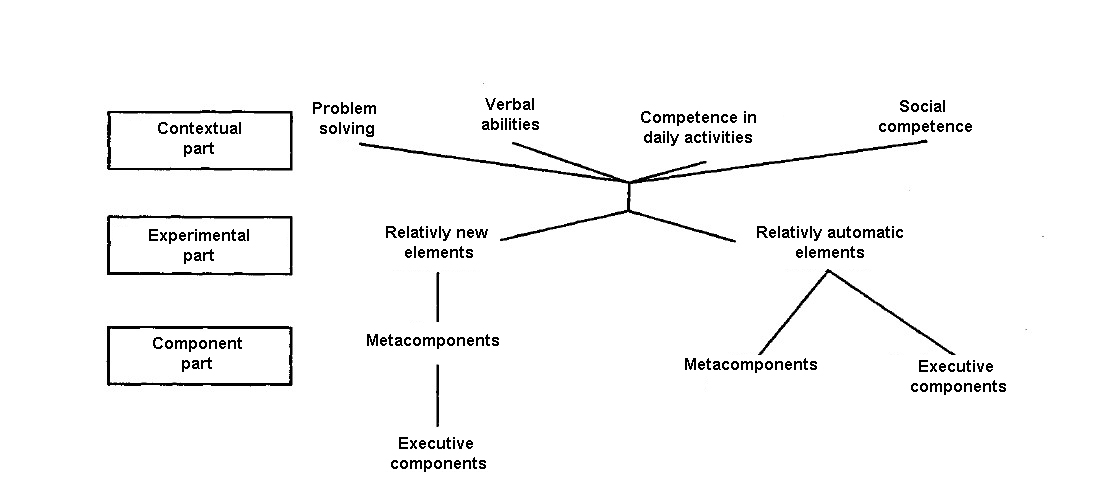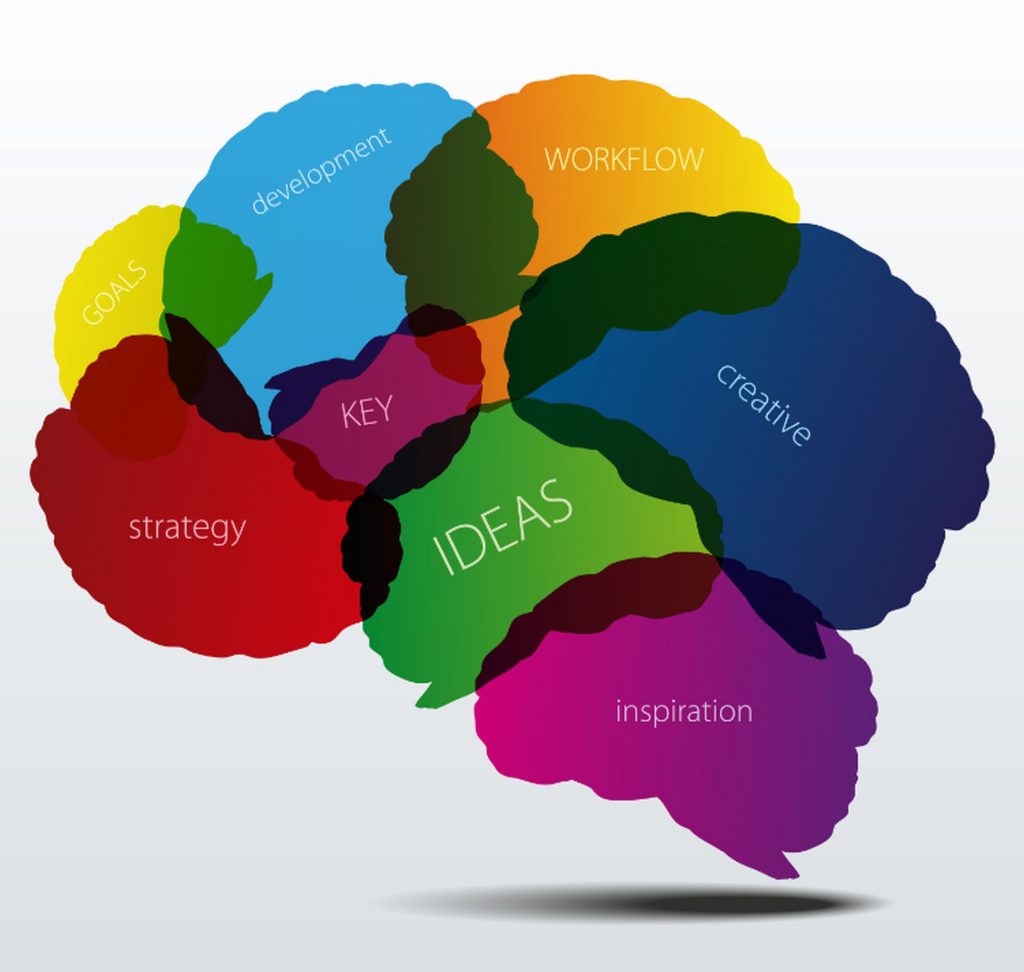Models of intelligence
In the beginning of 20th century scientists started trying to determine structure of intelligence. For today, we have a lot of different models of intelligence structure. In this article, we will take a look on them.
Spearman General Intelligence (g factor)
General intelligence, also known as g factor, refers to a general mental ability that, according to Spearman, underlies multiple specific skills, including verbal, spatial, numerical and mechanical.
Charles Spearman, an English psychologist, established the two-factor theory of intelligence back in 1904 (Spearman, 1904). To arrive at this theory, Spearman used a technique known as factor analysis.
Factor analysis is a procedure through which the correlation of related variables are evaluated to find an underlying factor that explains this correlation.
In the case of intelligence, Spearman noticed that those who did well in one area of intelligence tests (for example, mathematics), also did well in other areas (such as distinguishing pitch; Kalat, 2014).
In other words, there was a strong correlation between performing well in math and music, and Spearman then attributed this relationship to a central factor, that of general intelligence (g).
Spearman concluded that there is a single g-factor which represents an individual’s general intelligence across multiple abilities, and that a second factor, s, refers to an individual’s specific ability in one particular area.
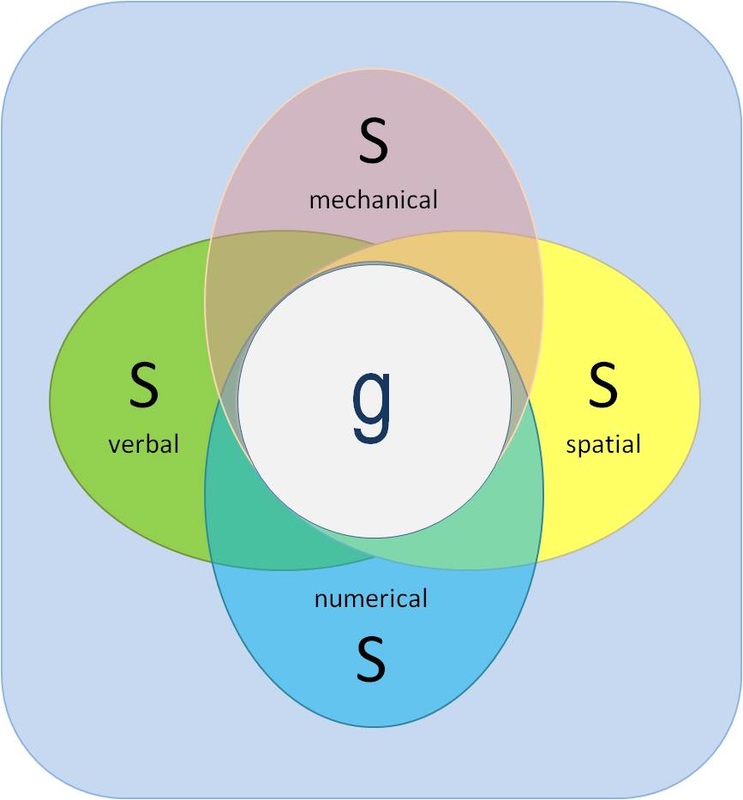
Model of intelligence by Thurstone
The Thurstone model of intelligence based on his theory about multiply factor. This was a challenge for a g-factor. After analyzing data from 56 different tests of mental abilities, Thurstone identified a number of primary mental abilities that comprise intelligence, as opposed to one general factor.
This is a list of mental abilities:
- Word Fluency - Ability to use words quickly and fluency in performing such tasks as rhyming, solving anagrams, and doing crossword puzzles.
- Verbal Comprehension - Ability to understand the meaning of words, concepts, and ideas.
- Numerical Ability - Ability to use numbers to quickly computer answers to problems.
- Spatial Visualization - Ability to visualize and manipulate patters and forms in space.
- Perceptual Speed - Ability to grasp perceptual details quickly and accurately and to determine similarities and differences between stimuli.
- Memory - Ability to recall information such as lists or words, mathematical formulas, and definitions.
- Inductive Reasoning - Ability to derive general rules and principles from presented information.
Model of intelligence by Guilford
The model is based on the assumption of three dimensions, the combinations of which determine various types of intellectual abilities. Each factor of intelligence is developed by a combination of one of the types of intellectual operations, the area in which it is produced (content), and the resulting result.
Guilford distinguishes five types of operations that make up the first dimension of the model: understanding information (C), memorization (M), divergent thinking, or production of logical alternatives related to the presented information her (D), convergent thinking, or the production of logical conclusions, (N) and evaluation - comparison and evaluation of information units by defined criteria (E).
The second dimension is defined in terms of contents or information presentation forms. information. The provided information, according to Guilford, can be figurative (F), symbolic (5), semantic (M) and behavioral (B).
The third dimension is the product, the result of the application of a certain intelligence operation to a specific content. The results appear in the form of separate elements, units (U), classes (C), relations (R), systems (S), transformations (T), and implications (I).
Thus, the existence of 120 (5x4x6) intelligence factors is assumed, each of which includes a combination of three symbols corresponding to the type of operation, the form of presentation of information and the result obtained.
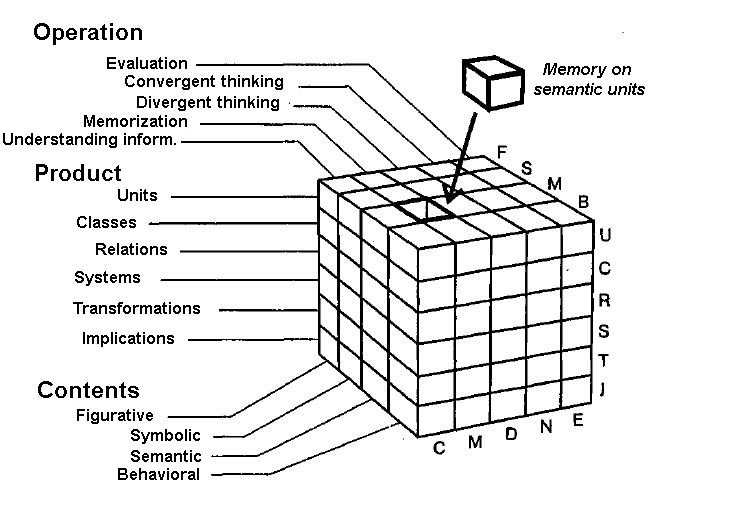
Model of intelligence by Eysenck
The Eysenck model was developed in 1979. Schematically his model looks like a cube, each of the planes of which represents different modalities: intellectual processes (thinking, memory, perception tie, etc.), test material (verbal, spatial, etc.) and, finally, what has been called "quality" (the speed and power of intellectual processes). Let us immediately explain that the strength (power) of the intellect consists of the insistence responsiveness in performing tasks and a tendency to check for errors.
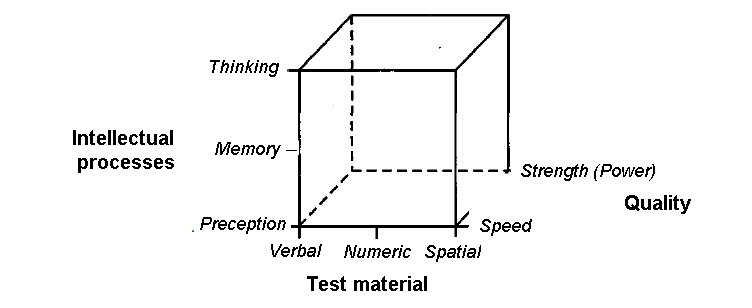
Model of intelligence by Cattell
Among modern models of the structure of intelligence, there is the most popular and the most developed concept proposed by Cattell in 1971. In this concept, it is assumed that the factor g is the sum of two common factors that have been obtained the names of fluid intelligence (gf) and crystallized intelligence (gc). Differences between factors gf and gc is the most elaborated aspect of the research of Cattell and his co-workers. That is why the name is: “The theory of fluid and crystallized intelligence".
The use of fluid intelligence to resolve emerging in front of a person problems leads as a result of learning to the emergence and development of crystallized intelligence, which appears as a condensate of our experience. Crystallized intelligence varies with culture, activity, personality interests and is measured by traditional intelligence tests.
Each manifestation of abilities, expressed in activity is a function of certain factors belonging to three classes:
- Central (or general) abilities are conditioned with structural and functional properties of the brain and affect all cognitive processes. It is purely speculatively assumed that the most relating factor to central abilities is gf, that can characterize the magnitude of the material substrate of cognition. Other factors are identified with the functional features of the brain. The central capabilities are the basis of fluid intelligence.
- Local abilities are related with both innate and acquired organization of sensory and motor areas of the brain. These abilities are discovered when performing tasks that require, for example, the implementation auditory or visual perception, as well as motor activity. Factors, which are included in local abilities, have a somewhat more limited impact on the success of fulfillment tests than those, that relate to the central abilities.
- Factors-operations in contrast to central and local abilities, are more closely related to the cultural experience of the individual. They are subdivided on acquired or auxiliary cognitive skills (intellectual algorithms) and specialized professional ones, i.e. skills acquired in order to achieve a goal. Cattell relates them to a crystallized intellect.
Schematic representation of Cattell's "reticular factor model" of intelligence illustrated on the picture:
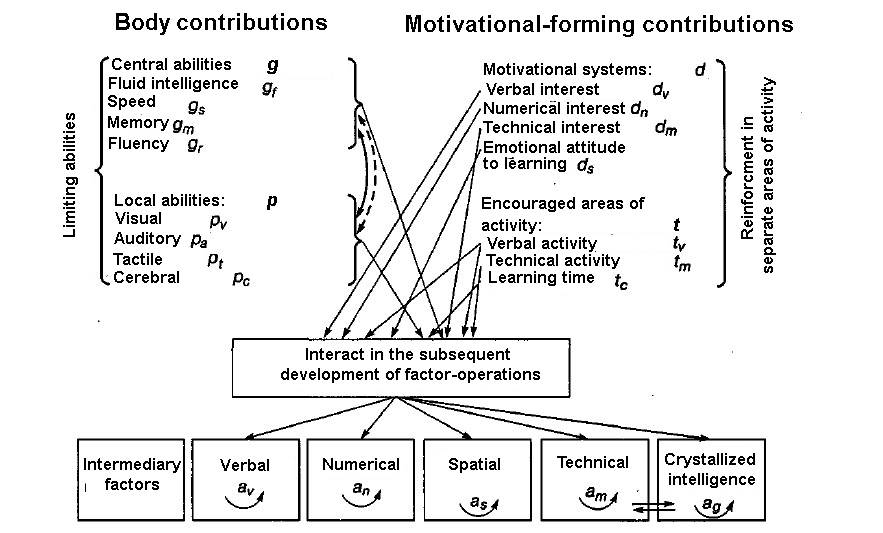
Model of intelligence by Sternberg
The model of intelligence, which has been developed by the American psychologist from Yale University Robert Sternberg, received wide recognition, fame and popularity. In the literature, it is usually called a triadic theory of intelligence. The author of this theory considers it similar with the theory of crystallized and fluid intelligence. It consists of three parts - contextual, component and experimental.
In the first, the contextual part, it is postulated that the intelligence is a mental activity related to the ability of an individual to adapt to changes in their environment, so that this adaptation optimally meets the requirements of the environment.
Intelligence, according to Sternberg, cannot be considered outside of sociocultural context. Therefore, intelligence may differ across groups of people, depending on differences in their environment.
The second part of the theory - component part, complements the first, it defines some elementary cognitive processes that contribute to optimal harmony between the environment and the individual. The basic, initial unit of the analysis in the component part of the theory - information and procedural component. A component is an elementary information process that operates when representing objects or symbols in the mind. The component can convert the sensory impulse into an abstract representation, one representation into another or into motor activity.
There are two types of components related to each other. First of all - metacomponents. In fact, they are executive processes of a higher order and function when a plan for solving task is produced, it's implementation is controlled, evaluation of results is required. There are six following metacomponents:
- Determining the nature of the problem that needs to be solved.
- Determination of the plan and the necessary components to solve the problem.
- The choice of one or more ways of organizing information, based on which the lower-order components will be activated.
- Organization of lower-order components into a whole and systematized problem solving strategy.
- Deciding on the distribution of attention and other procedural resources to solve different aspects of the problem.
- Monitoring the progress of problem solving.
The second type is executive components. These components are used in current implementation of the strategy for solving the problem. The following three types of executive components are involved in solving different problems:
- Encoding components.
- Combination and comparison components.
- Solution (response) components.
In the third, experimental part of the theory, it is indicated that intelligence most clearly manifested in the tasks or situations in which elementary cognitive processes function. To these situations or tasks the individual is trying to adapt successfully, these are relatively new situations, or reactions to them can take on an automatic character.
There are certain interdependencies between contextual, component and experimental parts of the triadic theory. Contextual part defines intelligence as the ability of a person to adapt to changes in the environment. The experimental part of the theory limits the contextual, pointing out that the best indicators of intelligence are success in solving new problems or in those whose solution is in the automatic process. Although these two factors - the novelty of the task and the automation of the interpretations clarify the understanding of intelligence as an adaptation, they are not enough for understanding the processes underlying intelligence. This requires the component part, which describes the general processes inherent in many types of behavior and at the same time characterizes specific processes that allow to understand individual differences in intellectual activity.
